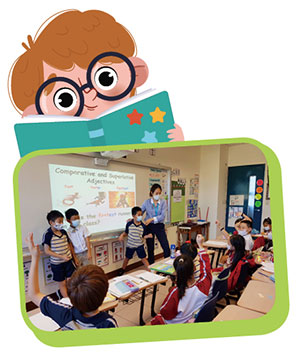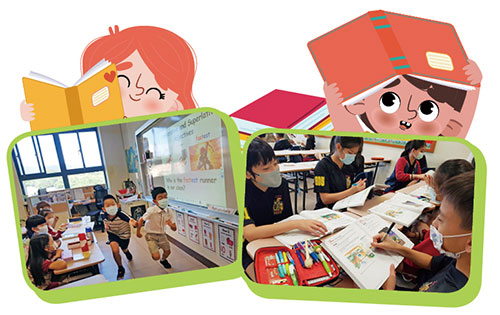
Happy Holidays!
國際處主任 賴國宜
English is a compulsory subject in almost all school levels in Taiwan. Most English textbooks are organized by grammar rules. The complexity and confusion of grammar formulas make learning English difficult for most students. We believe that grammar is very important to learning a foreign language, but the way of teaching grammar should be child-friendly. Instead of explaining abstract grammar rules explicitly, our teachers integrate grammar learning with authentic situations in which students are exposed to practical communication. You will find more teaching examples from Ms. Kim's article.
Christmas time is here once again! This year we continue the popular Christmas-spirit Calendar Activities, Gratitude Stockings and Carol Shows; and Candy Gram, which is brand new this year. While celebrating the holiday, children also learn to be caring and grateful. I would like to wish the merriest Christmas to you and your family.
從小學、中學到大學,英文一直都是重要的學科之一,大大小小的英文考試都離不開文法題型,大部分人學英文的經驗就是練習文法,有些人被困在複雜的文法規則裡,覺得學英文很難;有些人雖然考試成績優異,但是仍無法流暢的閱讀英文書籍或使用英文溝通。這樣的學習經驗,讓很多人得了「英文文法恐懼症」。英文不應只是一門學科,而應該是一種能力,文法可以幫助學習者更精準的詮釋閱讀和聽到的訊息,並在表達和寫作時,表現得更自然且貼切。課研組長Ms. Kim的文章說明,文法學習必須配合學生的認知發展跟真實生活情境連結,讓孩子在老師設計的情境裡自然的溝通,從中歸納出文法規則,最後內化並在實際生活中運用。
因為聖誕節,12月成為康橋孩子最期待的月份,國際處今年仍持續最受歡迎的聖誕月曆活動,每天都有驚喜陪大家一起度過歡樂溫馨的聖誕季節,今年還有一個新亮點是Candy Gram(糖果傳情),孩子可以用賺來的康橋幣購買聖誕卡和拐杖糖,英語村的小天使會幫大家傳遞給指定的師長或朋友。最後也是最精彩的是一、二年級寶貝的聖誕歌謠表演,將溫暖的祝福散播到所有的處室和班級。
在此,預祝所有的康橋家庭,闔家聖誕平安喜樂!


~ Kim Wang
Curriculum Coordinator, International Department
“Why do we need to learn grammar?” It’s a common question children ask. Under the influence of Asian culture and tradition, children in Taiwan often associate grammar with errors and corrections. Their aim of learning grammar is just to get a better score on tests, which naturally makes it the most boring part of learning English. However, grammar exists in our daily lives. It is the core of a language - from interpreting the meaning of a reading to conveying one’s own thoughts comprehensively in writing. So what can we do to motivate our children to find the purpose and realize the importance of learning grammar?
Intrinsic Motivation for Grammar Learning
Instead of explicitly teaching grammar, teachers at Kang Chiao plan motivating activities that allow students to seamlessly integrate their language learning with practical communication. The students are exposed to the rules, meanings, and uses of grammar in activities with highly interesting and authentic topics. For example, when students were learning comparative and superlative adjectives in Grade 2, they were introduced to a guessing activity. The teacher provided questions with different comparative or superlative adjectives, such as “Who is the fastest runner?” Students then naturally used the correct target grammar to answer, “Ray is the fastest runner.” The most intriguing part of this kind of activity is it usually creates motivation to communicate or argue. Then, students who were named to be the fastest runners had a short running to prove who was the fastest. Finally, the teacher encouraged students to analyze the sentences they answered with and concluded with the rules and meanings of that grammar point. Through these fun, practical, and communicative activities, students are highly engaged. The activities also motivate them intrinsically to practice using appropriate grammar in communication.

Discovering the Correct Usage of Grammar
Our fifth and sixth grade, students are encouraged to discover grammar structures from natural contexts, such as an article about giving suggestions for an appropriate gift, or a dialogue about sharing their travel experiences with classmates. This allows students to associate grammar learning with the skills they need in real-life situations and become more engaged when it comes to grammar. Taking grade 6 as an example, students read a conversation about preparing for a party. In the dialogue, a group of friends talk about what preparations have been done and who still needs to do theirs. One of the characters says, “I’ve already chosen the date and emailed the invitations.” Another says, “You still haven’t decided on the menu!” From the verb tense used in the dialogue, students figured out that the present perfect tense indicates something that has or has not been completed at some unspecified time in the past. Through activities like these, students learn the correct grammar patterns of English in a natural way. In addition, students also develop analytical skills and become autonomous when learning grammar.
Embracing a New Mindset
Traditionally, grammar was taught as a separate skill. However, when we instill a purpose in a grammar lesson, learning grammar becomes meaningful. It empowers students with an intrinsic drive to use and practice language in day-to-day scenarios. As a result, our students are able to apply what they’ve learned to construct correct sentences to convey their ideas meaningfully and with confidence.

![]() 全文下載)
全文下載)